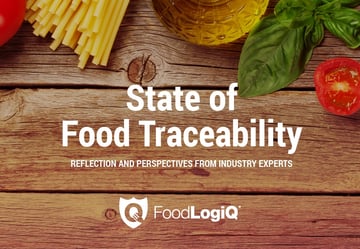FoodLogiQ recently hosted a webinar on one of the hottest topics in business and technology today: blockchain. This buzzword has generated significant interest and questions throughout the world of supply chain because of its supposed ability to solve a variety of different problems. FoodLogiQ’s Chief Marketing Officer Katy Jones, Chief Technology Officer Charles Irizarry, and Chief Product Officer Todd Dolinsky explore the fact, the fiction and the future of blockchain and its potential application within the food industry.
What is blockchain? What is it not?
Blockchain is an emerging technology offering a way for us to transact with each other and move assets around the world in a secure manner. What makes blockchain special is that it is a distributed and immutable ledger. There is no single point of failure in a distributed ledger—it is a consensus of replicated and synchronized digital data geographically spread across multiple sites. This decentralized structure makes the data resilient to a technology or organizational failure. In other words, blockchain records all the transactions against the ledger, and those transactions are recorded in chronological order. Every event that takes place is public to all participants. Everyone has a copy of the ledger, and transactions cannot be altered or deleted. This provides security through transparency.
For a true blockchain experience, the technical networking architecture must be “decentralized.” This means that instead of having one server or a central set of servers located in a data center somewhere, the blockchain is decentralized among many thousands of computers. All of those computers work in orchestration to validate data and transactions, keeping all records up to date.
What does blockchain look like in the food industry today?
Blockchain is not yet a proven solution in the food industry but holds tremendous promise on its potential to open up transparency in the food supply chain. There are a couple of proof of concepts that exist today and more are being added as companies pursue the concept. The majority are not what would be referred to as a "public" blockchains where all of the information is open and transparent. In fact, many are considered permissioned blockchains. To date, the vast majority of the blockchain applications launched in the food industry are permission-based.
Unfortunately, there have been many articles written about blockchain, over-hyping it as a ‘light-switch’ solution that, once implemented, suddenly provides complete transparency throughout your supply chain. That is not an accurate depiction of what it would really take to put a true blockchain solution in place. There must be acknowledgement of the extensive efforts required for data gathering and data quality, and a traceability program is key in order for any blockchain solution to be successful. As FoodLogiQ has rolled out our own traceability engine, we have gained a deep understanding of those efforts.
What could blockchain do for the food industry?
FoodLogiQ is excited about the increased conversation around blockchain in terms of traceability and how data is stored. As industry influencers, we are actively involved in shaping the standards that will drive a blockchain solution in the food industry. We’ve built a platform focused on helping suppliers, corporate brands, and other stakeholders throughout the supply chain get their data to each other using GS1 Standards and many other methods to standardize the data so that it’s highly transferable. Users are able to understand and have clear visibility into events that happen in chronological order, providing a clear map of their supply chain. All of these things have to happen before a blockchain can ever become successful.
FoodLogiQ is currently working with various industry associations and experts - including the Produce Marketing Association (PMA) and GS1 - to help define the data standards and requirements that would go into a blockchain solution. In the meantime, our platform has been designed in such a way that we can pivot and support the different technological innovations that can occur, whether it’s blockchain today, artificial intelligence (AI) tomorrow, or the next major tech evolution or solution.
As a supplier/manufacturer/operator, what can I do now to get ready?
The underpinning of blockchain readiness is getting your data in a standardized format. This process includes:
- Item identification and standardization: It’s important that everyone in your supply chain is using the same language with regard to a product’s name and location so that when data is being transferred back and forth, it can be aggregated. FoodLogiQ Connect accomplishes this by using a Global Trade Identification Number (GTIN) to uniquely identify the item name, as well as a Global Location Number (GLN) that provides its specific location.
- Data submission: Everyone along your supply chain needs to be able to share the data in one central repository. Using FoodLogiQ Connect, data can be uploaded in six different ways based on your company’s processes, procedures and technical capabilities.
- Analysis: Quality data is a great thing, but true visibility into your company’s supply chain occurs when users are empowered to evaluate that data and make intelligent decisions based on analysis. Through FoodLogiQ Connect’s Investigations function, you have the ability to set granular specifications to get the information you need.
If you are actively pursuing true end-to-end traceability for your organization in an effort to become blockchain-ready, FoodLogiQ offers the solution in a robust, proven platform today called FoodLogiQ Connect. To learn more watch the on-demand blockchain demo and to find out more about how we can help, visit foodlogiq.com/blockchain.
Other posts you might be interested in
View All Posts
Supplier Compliance
4 min read
| October 16, 2019
Food Traceability: a Movement with Momentum
Read More
Traceability
2 min read
| September 15, 2017
GS1 and Blockchain: What this Means for the Food Industry
Read More
Food Industry
5 min read
| July 5, 2018
